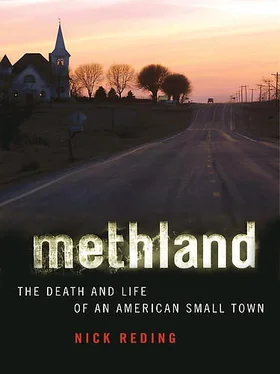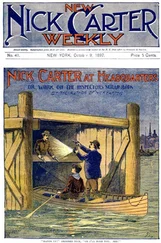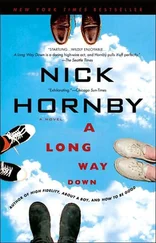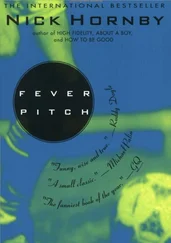The rest of the meth high, though, is not high at all. The shoulder period is when Jarvis’s euphoria first plateaus and then decreases dramatically, on its way to falling completely to the floor. The fall itself is what’s called the tweak, so named for the physical manifestations of what amounts to the brain’s running on empty. The stores of neurotransmitters now depleted, and their synaptic effect no longer consistent with a sense of well-being, Jarvis becomes increasingly agitated. Tests on mice at the Scripps Research Institute by Dr. Kim Janda suggest an attribute unique to meth that would prove cause for increased agitation, to be sure: The body actually forms antibodies, effectively vaccinating itself against the drug and thereby making the “high” increasingly difficult to achieve. This, Dr. Janda’s research indicates, results in a kind of self-perpetuating biochemical loop: the more meth Jarvis does, the more difficult it is to get high, leaving him no choice but to do more meth.
Unaware of how hard his body has been working, and the deficit at which he is operating, Jarvis begins to show physical depletion. Shaking hands, severe sweats, muscle cramps, and shortness of breath are all symptoms of the impending withdrawal. So, too, does the paranoid conviction set in that he’s being followed—like the belief that a black helicopter was hovering above his house. (This hallucination is common; I heard the exact same story from dozens of addicts in Alabama, Illinois, Kentucky, Georgia, and California.) The desperation to make more meth, at what ever cost, and the hallucinations have been the defining features of Jarvis’s life for nearly a decade. Every time he came home from jail, he was cash-stricken and eager to feel good, and he redoubled his lab’s output.
Dr. Clay Hallberg was the company doctor at Iowa Ham when it was bought by Gillette in 1992. Within a year, he’d called the plant manager, an old friend who’d worked with Clay’s cousin years before at a Hy-Vee grocery store in Cedar Rapids. Clay told the manager that he’d noticed an unsettling decline in the morale of the workers coming to see him since they’d lost their benefits. Clay was worried about the increase in drug use as well; more and more workers, suffering from depression now that they’d lost two thirds of their income overnight, were turning to meth. The plant manager said he’d look into it. A week later, Clay was fired.
That the surge in meth use in Oelwein was a direct result of wage cuts at the Gillette plant would be hard to argue convincingly. After all, Roland Jarvis had already been using the drug for several years at that point. But it would be naive not to see those wage cuts as yet another difficult turn in the financial fortunes of Oelwein, just as it would be foolish not to notice the 400 percent increase in local meth production that happened at the same time, as reflected in the number of labs busted in Oelwein. Or, moreover, not to see the link between a steady long-term rise in the abuse of a drug associated with hard work and a steady long-term decline in the amount of work available in rural America’s defining industries. Not long after buying Iowa Ham, Gillette sold the plant to Iowa Beef Products (IBP); in 2001, Tyson bought the plant. With each sale, the number of workers was further cut and wages remained stationary despite rising inflation. In January 2006, Tyson closed the plant for good. By then, the initial workforce had been reduced from over eight hundred people to ninety-nine, a remarkable, devastating loss of revenue in a town of only six thousand.
The association between meth and work is part of why Dr. Stanley Koob, a neuropharmacologist at the Scripps Research Institute, and widely considered to be the world’s leading expert on drug addiction, considers methamphetamine to be “way up there with the worst drugs on the planet.” Hard work and meth conspire, says Koob, in formulating the drug’s “social identity,” which is essentially an attempt to analyze how acceptable a drug is. For eight decades, from the time Nagayoshi Nagai first synthesized meth in 1898 until the early 1980s, meth was a highly acceptable drug in America, one of the reasons being that it helped what Nathan Lein calls “the salt of the earth”—soldiers, truck drivers, slaughterhouse employees, farmers, auto and construction workers, and day laborers—work harder, longer, and more efficiently. It’s one thing for a drug to be associated with sloth, like heroin. But it’s wholly another when a formerly legal and accepted narcotic exists in a one-to-one ratio with the defining ideal of American culture. Meth’s most disastrous physical and psychological effects develop more slowly than its rate of addiction; one’s lucidity and ability to concentrate actually increases short-term. Add this to the fact that ours is a culture in which the vagaries of hard work are celebrated as indicators of social worth, and the reasons to do crank are in fact quite often—initially, at least—more numerous and compelling than the reasons not to do it. So much so that Patricia Case calls meth “the most American drug.” In the metric that took hold of Oelwein at the beginning of the 1980s with the farm crisis—and extended through the next decade with the complicated demise of Iowa Ham—the ability to make something in your basement that promised work, success, wealth, thinness, and happiness was not necessarily too good to be true.
One day in May 2005, Roland Jarvis sat in the living room of his mother’s tiny new two-bedroom house in a wobbly three-legged La-Z-Boy covered in what looked like orange and brown carpeting. Outside, the world was fairly ecstatic with the first temperate, blue-skied day of spring following so much rain in northern Iowa. Nonetheless, Jarvis was watching TV with his back to the windows, the heavy curtains drawn tight against the warm sun. His face was thin beneath the baseball cap that he wore over his short blond hair. Visible in the semidarkness were fine bones and bright, shining blue eyes around which Jarvis’s skin had liquified and reset in swirls. He rubbed at where his nose had been and coughed violently. Jarvis had just smoked a hit of meth by holding the glass pipe with his rotted teeth. Using what was left of his right hand, he jostled the lighter until it wedged between the featureless nub of his thumb and the tiny protrusion of what was once his pinkie, managing somehow to roll the striker of the red Bic against the flint. Suddenly, his eyes were as wildly dilated as a patient waiting in the low light of an ophthalmologist’s office.
At thirty-eight, Jarvis had become a sort of poster boy around Oelwein for the horrific consequences of long-term meth addiction. Like Boo Radley, he hardly ever ventured out, though his was nonetheless a heavy presence in town. In two months, Jarvis was going back to jail, this time for possession of drug paraphernalia. (His sixty-year-old mother would be joining him in the lockup for the same offense.) He wore warm-up pants and wool socks. He was always cold, he said, and hadn’t slept more than three hours at a time in years. His skin was still covered in open, pussing sores. He had no job and no hope of getting one. The last time he “went uptown,” as he calls going to a Main Street bar, was eighteen months earlier. That night he was in his old hangout, the Do Drop Inn, when another customer hit Jarvis in the face because he wanted to know what it was like to slug a man with no nose.
“That,” says Jarvis, “kind of put a damper on my Saturday night fever.”
Nowadays, the one thing that could get him up and moving were the weekly visits he was allowed with his children, two girls and two boys, ages sixteen to nine. For the most part, he would accompany them to the town lake, out past the Country Corner Café, on the way south to Hazleton. There, weather permitting, Jarvis and his kids would fish for a few unsupervised hours, hoping to catch some bullheads and bluegills to fry for supper. Sometimes he would accompany the kids back to their mother’s home for that purpose. He and his ex-wife were, he says, still on pretty good terms, given what he’d done to their lives.
Читать дальше












